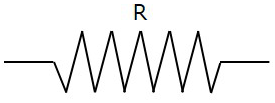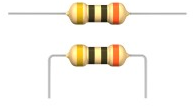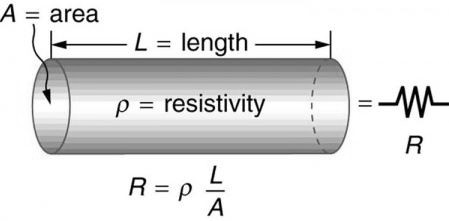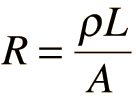The property of a material that opposes the flow of current through it, is called electrical resistance or simply resistance. The symbol of resistance is shown in the fig. 1.

Practically, the electrical components that offers certain opposition (resistance) to the flow of current in the circuit is known as resistor. Fig. 1(b) shows some resistors.

Units of measurement of Resistance
The SI unit of electrical resistance is the ohm (Ω).
Every material will have some amount of resistance except superconductors which have zero resistance. The materials which have very low resistance are called conductors. The inverse of resistance is called conductance. Resistors are used to control the amount of current passing through conductors. But they dissipate the energy in form of heat and thereby the efficiency of the system decreases.
Determination of resistance

- The resistance of a material generally depends on its geometry and the property of the material.
- The resistance of a material also depends on the temperature.
- The resistance of a wire of uniform area of cross section is proportional to its length and its resistivity and inversely proportional to the area of cross-section.
- It is represented mathematically as

where R= Resistance of the material in Ω (ohm)
ρ= resistivity of the material in ohm-meter (Ωm)
L= length of the material in meters
A=area of cross-section of material in m2
Ohm’s law can be used to determine the resistance of linear materials by measuring the voltage and current across it.
Ohm’s law is given by
V=IR at a constant temperature.
where V= voltage across the material
R= Resistance
I= current passing through it.
Not all materials obey ohm’s law but are generally valid for the conductors. The materials or circuit elements which strictly obey ohm’s law i.e. having linear V-I characteristics are called as ohmic materials or ohmic circuit elements. Example, metals.
The materials or circuit elements which do not obey ohm’s law strictly i.e. having non-linear V-I characteristics are called as non-ohmic materials or non-ohmic circuit elements. Example, semiconductors diodes, vacuum tubes, thermistors, etc. Hence ohm’s law cannot be applied to determine the resistance of such materials.
What is the Difference between resistance and resistor?
A resistor is an electric component with a predetermined electrical resistance, like 1 Ω, 10 Ω, 100 Ω, 10000 Ω, etc. whereas resistance is the property of a material, which determines the quantity of current that passes through it when a potential difference is applied across it.
The resistors are colour coded to identify the value and function.
Effect of Temperature on Resistance
At room temperature, the metals have positive temperature coefficient whose resistivity increases with temperature. The semiconductors have negative temperature coefficient whose resistivity decreases as temperature is increased. The resistivity of insulators may increase or decrease depending on the system.
Resistor materials
Resistors are made of various materials of less conductivity. The following are the various materials used to make resistors.
1. Manganin: Manganin is an alloy of Copper, Manganese and Nickel. It has a nominal composition of 84% Copper, 12% Manganese and 4% Nickel.It has high resistivity nearly 25 times that of the copper.
2. Nickel Chromium Alloy: This alloy has a higher temperature coefficient of resistivity than Manganin and Constantan. The most important property of this alloy is that it remains stable and corrosion resistant even at a higher temperature.
3. Constantan: It is an alloy of Nickel and Copper containing 40% to 60% Nickel with a small amount of Manganese to improve the mechanical properties.
4. Gold Chromium: It is an alloy of Gold and Chromium having 2% chromium. This alloy has resistivity about 20 times that of Copper.
Questions & Answers
Q. Define 1 ohm.
Answer. The resistance of a conductor is said to be 1 ohm, if a current of 1 A flows through it when potential difference of 1 V is applied across it.
Q. What is the dimensional formula of resistance?
Answer. The dimensional formula of resistance is [ML2T-3A-2]

1 thought on “Electrical Resistance | Resistor materials”